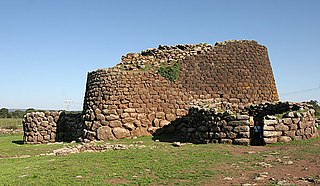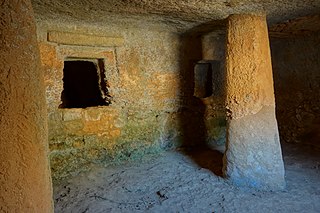
Nuoro is a city and comune (municipality) in central-eastern Sardinia, Italy, situated on the slopes of the Monte Ortobene. It is the capital of the province of Nuoro. With a population of 36,347 (2011), it is the sixth-largest city in Sardinia.

The nuraghe, or also nurhag in English, is the main type of ancient megalithic edifice found in Sardinia, developed during the Nuragic Age between 1900 and 730 B.C. Today it has come to be the symbol of Sardinia and its distinctive culture known as the Nuragic civilization. More than 7,000 nuraghes have been found, though archeologists believe that originally there were more than 10,000.

Olbia is a city and commune of 60,346 inhabitants in the Italian insular province of Sassari in northeastern Sardinia, Italy, in the historical region of Gallura. Called Olbia in the Roman age, Civita in the Middle Ages and Terranova Pausania before the 1940s, Olbia was again the official name of the city during the fascist period.

Giants' tomb is the name given by local people and archaeologists to a type of Sardinian megalithic gallery grave built during the Bronze Age by the Nuragic civilization. They were collective tombs and can be found throughout Sardinia, with 800 being discovered there.

Domus de Janas are a type of pre-Nuragic chamber tombs found in Sardinia. They consist of several chambers quarried out by the people of the San Ciriaco through Ozieri cultures and subsequent cultures, resembling houses in their layout.

Sant'Antioco is the name of both an island and a municipality (comune) in southwestern Sardinia, in the Province of South Sardinia, in Sulcis zone. With a population of 11,730, the municipality of Sant'Antioco it is the island's largest community. It is also the site of ancient Sulci, considered the second city of Sardinia in antiquity.

Guspini is a town and comune of about 12,000 inhabitants in west Sardinia (Italy), in the province of South Sardinia. It is 62 kilometres (39 mi) from the capital Cagliari and 14.6 kilometres (9.1 mi) from the railway station at San Gavino Monreale.

Su Nuraxi is a nuragic archaeological site in Barumini, Sardinia, Italy. Su Nuraxi simply means "The Nuraghe" in Campidanese, the southern variant of the Sardinian language.
San Giovanni Suergiu, Santu Giuanni de Suergiu in sardinian language, is a comune (municipality) in the Province of South Sardinia in the Italian region Sardinia, located about 50 kilometres (31 mi) west of Cagliari and about 4 kilometres (2 mi) south of Carbonia.

The Nuragic civilization, also known as the Nuragic culture, was a civilization or culture on Sardinia (Italy), the second largest island in the Mediterranean Sea, which lasted from the 18th century BC up to the Roman colonization in 238 BC. Others date the culture as lasting at least until the 2nd century AD and in some areas, namely the Barbagia, to the 6th century AD or possibly even to the 11th century AD.

Marmilla is a natural region of southern-central Sardinia, Italy. Etymology The name "Marmilla" comes from the vast rounded hills, probably resembling udders. Another hypothesis is that according to which given the presence of many marshes in the area, the landscape could appear dotted with "a thousand seas". Tourism in the Marmilla can rely on various factors ranging from environmental assets, to the numerous Nuragic centers in the area, to architectural works. In particular, we note:

The Ozieri culture was a prehistoric pre-Nuragic culture that occupied Sardinia from c. 3200 to 2800 BC. The Ozieri was the culmination of the island's Neolithic culture and takes its name from the locality where early findings connected with it have been found, the cave of San Michele near Ozieri, in northern Sardinia. The Ozieri existed contemporaneously with the Arzachena culture, sharing some similarities, and its influence also extended to nearby Corsica.
Sardinia is the second largest island in the Mediterranean Sea and an autonomous region of Italy. Tourism in Sardinia is one of the fastest growing sectors of the regional economy. The island attracts more than a million tourists from both Italy, from the rest of Europe, and, to a lesser degree, from the rest of the world. According to statistics, tourist arrivals in 2016 were 2.9 million people.

The Giants of Mont'e Prama are ancient stone sculptures created by the Nuragic civilization of Sardinia, Italy. Fragmented into numerous pieces, they were discovered in March 1974 on farmland near Mont'e Prama, in the comune of Cabras, province of Oristano, in central-western Sardinia. The statues are carved in local sandstone and their height varies between 2 and 2.5 meters.

The necropolis of Anghelu Ruju is a pre-Nuragic archaeological site located north of the city of Alghero, Province of Sassari, Sardinia. It is the largest necropolis of pre-Nuragic Sardinia.

The necropolis of Is Loccis-Santus is an archaeological site located in the municipality of San Giovanni Suergiu, Sardinia. Dated to the 3rd millennium BC and used until the early centuries of the 2nd millennium BC, consists of thirteen Domus de janas. The artefacts found inside the tombs, mostly ceramics and other grave goods, are attributable to the Ozieri culture, Abealzu-Filigosa culture, Monte Claro culture, the Bell Beaker and Bonnanaro culture and are now exposed in the Villa Sulcis museum of Carbonia.

The necropolis of Pranu Muttedu is one of the most important funerary areas of pre-Nuragic Sardinia and is located near Goni, a small village in the province of South Sardinia. The complex has the highest known concentration of menhirs and megaliths in Sardinia, two megalithic tombs and a Domus de Janas surrounded by stone circles.

The necropolis of Santu Pedru is an archaeological site of the municipality of Alghero, Sardinia.

The Sardinian Romanesque is the Romanesque architectural style that developed in Sardinia. The Romanesque architecture in Sardinia has had a remarkable development since the early origins, during the Giudicati era, and for a long period. His expressions, although autonomous, are not classifiable in a recognizable image, since in the island the Romanesque manifested itself with unusual results but in numerous forms; this is due to the establishment in Sardinia of several religious orders, coming from various Italian regions and from France. Consequently, in the architectures of that era Pisan, Lombard and Provençal influences are recognizable as well as traces of the passage of workers, coming from the Iberian Peninsula, of Islamic culture.

The Civic Archaeological Museum "Alle Clarisse" of Ozieri is one of the most important museums in Northern Sardinia. Since 2003 it has been transferred to the former Poor Clares' convent. Its showcases contain the most significant finds found in the municipal area of Ozieri: the materials on display date from prehistoric times to the Modern Age.


















